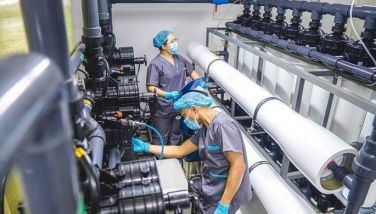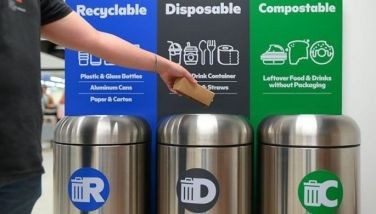Hope in a little red can
MANILA, Philippines - Coca-Cola gives Filipinos more reason to love it as the world’s leading beverage brand embarks on programs that inspire hope and improve the lives of its countless consumers.
For most of us, Coca-Cola is just a brand, but to countless Filipino schoolchildren, female sari-sari store owners, and members of rural communities all over the country, the iconic beverage company has become synonymous with attaining a better life through education, health, livelihood, and water.
At a recent gathering hosted by Coca-Cola Philippines, top-ranking executives led by Coca-Cola Foundation Philippines president Cecile Alcantara, Coca-Cola corporate communications manager Gilda Patricia Maquilan, and Coca-Cola vice president for public affairs and communication Atty. Adel Tamano, proudly shared how the leading beverage company is fulfilling its commitment to helping make a difference in the lives of its consumers through projects aligned with the holistic global framework known as “Me, We, World.â€
“As a beverage company, we always try to look for a connection on how our business can help society,†explains Maquilan of how Coca-Cola chooses its advocacies and causes. “We also factor in the needs of the markets where we operate, and we’re committed to giving back to nature and communities. Essentially, we try to find the sweet spot by which our company and the community can complement each other.â€
As such, the brand that quenches the thirst of millions of consumers worldwide is also behind NutriJuice, a vitamin- and mineral-packed drink formulated to address iron deficiency anemia among Pinoy public elementary school children between the ages of six and 12. Since NutriJuice was introduced in 2008, over 200,000 school children across the archipelago have benefitted from the 120-day program administered in their respective schools. This year, the goal is to enroll 35,000 iron-deficient kids into the said program.
Meanwhile, thousands of disadvantaged kids like Jenny Sanchez, who became the first Aeta to graduate from Tarlac’s Malasa Elementary School, are thriving in Little Red Schoolhouses or classrooms set up in remote parts of the country by Coca-Cola in partnership with the Department of Education and the Philippine Business for Social Progress. The advocacy, which started in 1997, has thus far spawned over 100 school buildings around the country, providing education, livelihood, and hope to close to 600,000 children and over 3,000 teachers. The 101st Little Red Schoolhouse in Sta. Rosa, Laguna, was just inaugurated recently, and according to Atty. Tamano, the company has committed to building 10 more by the end of 2013.
Sari-sari store owners like stay-at-home mom of four Celia Simeon may not have had the benefit of higher education, but that doesn’t mean it’s too late for her to learn. Aling Celia, in fact, is a fitting candidate for Coca-Cola’s Sari-Sari Store Training and Access to Resources (S3TAR), an initiative that provides women who run sari-sari stores the opportunity to learn entrepreneurial skills in a 12-week program that also extends access to capital and merchandise as well as peer mentoring to its participants. The Technical Education and Skills Development Authority (TESDA), various NGOs, LGUs, and micro-finance firms are among its partners.
Coca-Cola chairman and CEO Muhtar Kent’s call to empower five million women entrepreneurs by year 2020, the Philippines’ S3STAR aims to contribute 100,000 women sari-sari store owners to that figure. According to Atty. Tamano, sari-sari stores account for 60 percent of the company’s sales volume.
An estimated 90 percent of sari-sari stores are owned and operated by women. Since S3TAR’s launching in 2010, 10,000 women from key cities have completed the program, and as of this writing, batches of sari-sari store owners from Cagayan de Oro and Bacolod are among its fresh graduates. “The S3TAR is a recognition of how important women are not just to our business but as engines of economic growth for the Philippines,†adds Tamano.
Finally, 4,000 families in far-flung mountainous regions of Sagada, Pangasinan, Bulacan, Rizal, Negros Oriental and Occidental, Cotabato, Sultan Kudarat, and Palawan are finally enjoying a necessity many of us take for granted — sustainable access to clean, potable water. In an effort to return to nature and communities the amount of water equivalent to what it used in its production of its beverages, Coca-Cola introduced its Agos Ram Pump project in 2011 together with partners Earth Day Network and the Alternative Indigenous Foundation, Inc.
No fossil fuel and very little moving parts are required to make the pump work. Instead, the project employs a 200-year-old technology that uses free-flowing water’s natural kinetic energy to transport up to 100,000 liters a day to upland communities. For the first time in years, people from barrios need not endure the arduous, hours-long walk up and down mountains to bring limited supplies of water to their homes.
While Coca-Cola already installed 25 ram pumps in various localities and has committed to a target of 70 units this year, the No. 1 provider of sparkling beverages, juices, teas, and energy drinks is also mindful of how much water it consumes to create its beloved products. “In the Philippines, we have made significant progress in reducing water usage in our manufacturing operations by 50 percent, compared to five years ago,†says Alcantara.



















